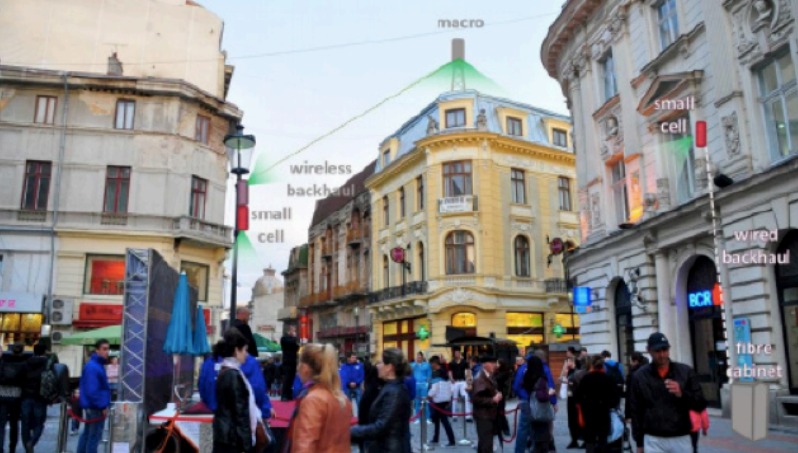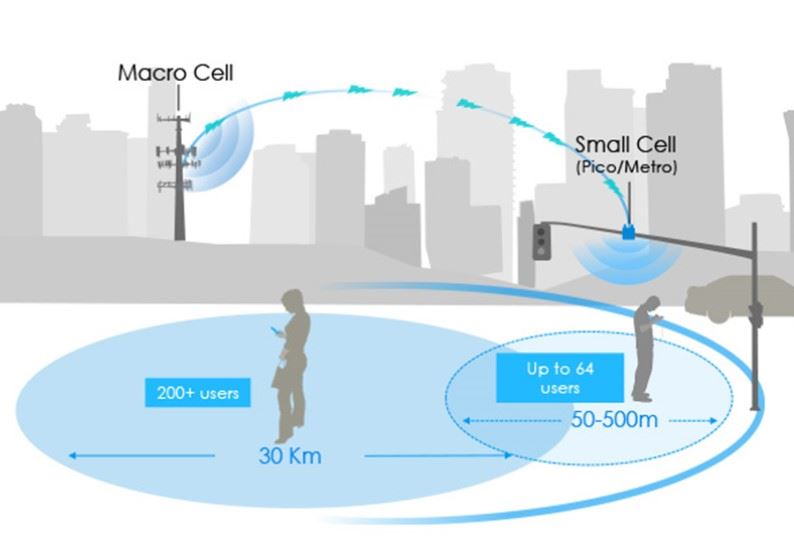Introduction
Traditional mobile networks are used to implement macrocells. These are large cells typically mounted on a mast or rooftop in cities and towns, alongside motorways or on rural hills. Macrocells have a radio coverage range of a few kilometres to tens of kilometres and are served by a high-powered cellular base station.
However, the surge increase in mobile data traffic volumes over the current decade has obliged operators to upgrade their network capacity. So one of the most effective approaches is to enhance the spatial reuse of limited spectrum through the dense deployment of Small Cells to complement existing macro cellular networks.
What are Small Cells?
‘Small cells’ is an umbrella term for operator-controlled, low-powered base stations that provide mobile and internet services within localised areas. Small cells typically have a range from ten metres to several hundred metres. These contrast with a typical mobile macrocell that might have a range of up to several tens of kilometres.
The term ‘small cells’ covers femtocells, picocells, microcells and metro cells that are used in the residential, enterprise, urban and rural environments. Also, The antennas are much smaller than those deployed at the macrocell sites and are often attached to buildings, rooftops and structures in the public rights-of way (ROW), including utility and light poles and other street furniture.

Small Cells in Real Environment
Macrocell vs. Small Cell
Although they serve different purposes, macrocell and small cell technologies complement each other.

Macro Cells Vs. Small Cells
- Macrocell: Traditional macrocell towers have a coverage area that spans several miles. They’re hard to miss, although their signal degrades towards the edge of their coverage areas.
- Macrocell technology is much better for large, low-density populations like quiet residential areas.
- Small Cell: Small cell technology is much more discreet, mounted on existing structures like rooftops and
utility poles. Sometimes, they are accompanied by refrigerator-sized equipment.
Because small cells only supply a few hundred feet of coverage, they are best suited for dense areas like downtowns.- Small cells are perfect for small, dense-population areas with high-capacity needs. Downtowns, stadiums and theme parks are ideal for this technology.
What is Motivating Dense Small Cell Deployments?
Mobile network operators face the continuous challenge of upgrading their networks in response to ever-growing traffic volumes attributed to the increased adoption of smart devices (e.g., smartphones, mobile virtual reality platforms etc.) and bandwidth-intensive services (e.g. 4K/8K video streaming).
In view of this traffic growth, mobile operators may upgrade their networks to radio technologies providing higher network capacities and user throughput. A currently common scenario is for operators to maintain multi-standard radio access networks that include 4G technologies and preceding technology generations. However, 4G network enhancement and/or expansion is ongoing Mobile operators, equipment vendors and other industry stakeholders are already aggressively developing the 5G network technologies, which will support emerging connectivity needs for the next decade and beyond.
The main drivers behind this preference for small cells are:
- Improving network coverage: small cells can ensure connections indoors, outdoors in rural areas, on aircraft, ships, and trains (over 80% of all mobile usage occurs inside buildings).
- Enhancing spectrum efficiency: exploiting existing spectrum in a more efficient way, allowing spectrum license holders to derive more value from their existing spectrum assets.
- Improving network capacity: small cells can increase cellular capacity in a given area more efficiently than placing more macrocells.
- Lowering energy requirements: The relatively lower energy consumption of small cells may lessen the carbon footprint of mobile networks and increases the possibility to leverage renewable energy sources for network operations.
What Power Levels Do Small Cells Transmit?
The technical forum for standardisation of mobile technologies defines small cells in terms of their transmitted power. Medium Range small cells typically transmit at power levels between around 0.25 and 6 watts per transmit connector (i.e. up to 12 W per access point).
Residential-type small cells (femtocells) operate at very low transmit powers, covering a typical sized residence and transmitting less than 0.1 watts (making them comparable with standard WiFi access points). More usually they operate at powers below 0.02 watts.
Enterprise small cells typically transmit at power levels between around 0.02 watts and 0.25 watts, with a range of up to around 200 metres, depending on the desired quality of service and number of simultaneous multiple users.
Urban small cells typically transmit at power levels between around 0.25 and 6.0 watts, giving extra coverage and capacity to serve multiple users.
Deploying Small Cells Wherever Needed
The term ‘small cells’ covers femtocells, picocells, microcells and metro cells that are used in residential (Home BS), enterprise (Local Area BS), urban and rural environments (Medium Range BS). Small cell deployments that are interconnected are also termed distributed antenna systems (DAS) or inbuilding systems (IBS) where they provide service within an existing structure.
The typical small cell deployment scenarios are outdoor deployments in urban and rural areas and mostly indoor deployments in enterprise spaces like Malls and stadium venues for the below reasons:
- High Capacity: Significant capacity gains compared to macro-only deployment.
- Low-Cost Deployment: Minimal CapEx & OpEx and leverages existing premises and backhaul.
- Easy to Deploy: Simple plug-n-play by customer.
Small cells will be deployed in areas of high demand without detailed RF planning.
Conclusion
Small cells deployment is an important option for mobile networks as they evolve to address the growing demand for mobile connectivity, improved capacity, and coverage.
References
- Small Cell Forum (www.smallcellforum.org).
- GSMA (www.gsma.com).
- Mobile Manufacturers Forum (www.mmfai.org).
- Qualcomm, Small Cells & UltraSON White Paper.
- Huawei, MWC 2016, Five Trends to Small Cell
